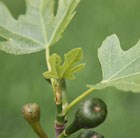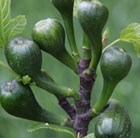Price reductions at Crocus
by Sarah - May 20th, 2010.Filed under: Crocus, Price Reductions.
Crocus has cut the price of these items

white fig was £12.99 now £9.99
Position: full sunSoil: will tolerate most soils, except very badly drainedRate of growth: averageOther features: medium-large, light-coloured fruit (August to September)Hardiness: fully hardy (borderline)A superb, deciduous, spreading shrub with decorative, 3- or 5- lobed, mid-green leaves. It is best grown against a south or south-west facing wall and in long hot summers masses of lighter-skinned, pear-shaped figs are produced. This fig is native to Tuscany where it’s used in a variety of dishes. The fruit is rich and sweet and ready to pick from August to September.Garden care: Plant in a 40cm (15in) pot in the ground or in lined pit to restrict root growth – unrestricted root growth leads to poor fruiting. Prune in summer, trimming all shoots back to about 5 leaves from the main stem. Remove any frost damaged or weak branches in springFigs are capable of producing three crops of fruit every year, but in our climate it is the tiny little ones that you find tucked into the leaf axils in autumn, that if protected from frosts, will go on to ripen in their second summer. Therefore if you are growing the fig for its fruit rather than its foliage, you should remove any developing fruits that are larger than a pea in autumn, and either cover the crown of the tree with a blanket of frost fleece or try to gently pack it with straw. This will keep them snug and warm throughout winter and push the plants energy into the development of the young fruits, which should grow into fully ripened figs next year.

black fig was £12.99 now £9.99
Position: full sunSoil: will tolerate most soils, except very badly drainedRate of growth: averageOther features: medium-large, brown fruit (August to September)Hardiness: fully hardyDecorative 3- to 5-lobed leaves on a deciduous, spreading shrub. To ensure a good crop of figs, it is best planted against a south-facing wall. From August to September a crop of pear-shaped fruit, green when young maturing to deep purple or dark brown, will be ready for picking and eating if the tender, developing fruits are protected in their first winter. This fig is traditionally grown in the Valencia region in Spain, which is noted for its favourable microclimate, and the fruits are so delicious, they are the first choice for leading greengrocers.Garden care: Plant in a 40cm (15in) pot in the ground or in a lined pit to restrict root growth – unrestricted root growth leads to poor fruiting. Prune in summer, trimming all shoots back to about 5 leaves from the main stem. Remove any frost damaged or weak branches in spring.Figs are capable of producing three crops of fruit every year, but in our climate it is the tiny little ones that you find tucked into the leaf axils in autumn, that if protected from frosts, will go on to ripen in their second summer. Therefore if you are growing the fig for its fruit rather than its foliage, you should remove any developing fruits that are larger than a pea in autumn, and either cover the crown of the tree with a blanket of frost fleece or try to gently pack it with straw. This will keep them snug and warm throughout winter and push the plants energy into the development of the young fruits, which should grow into fully ripened figs next year.






